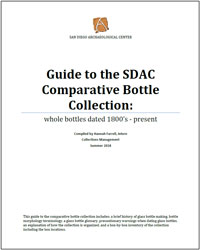Comparative Collections
Comparative Bottle Collection
This guide to the comparative bottle collection includes: a brief history of glass bottle making, bottle morphology terminology, a glass bottle glossary, precautionary warnings when dating glass bottles, an explanation of how the collection is organized, and a box-by-box inventory of the collection including the box locations.
The collection is first organized A-Z by manufacturing company (of the container, not the product inside). Within each company, the containers are then divided by container type (i.e. beer/ale, chemical, medicinal, etc.) and additional information regarding each bottle’s approximate manufacture range, manufacture style, finish style, and presumed contents can be found in the catalog and brief summary of the collection below.
At the end of the collection, there are containers with unidentified manufacturer marks or no marks at all that were still deemed to be of use to the collection. The containers with identifiable product manufacturers are divided by container type and those without are divided by manufacturing style (i.e., automatic, turn/paste mold, cup bottom mold, etc.).
More information on these containers can be found in the brief summary of the collection in this guide and within the collection’s catalog.
